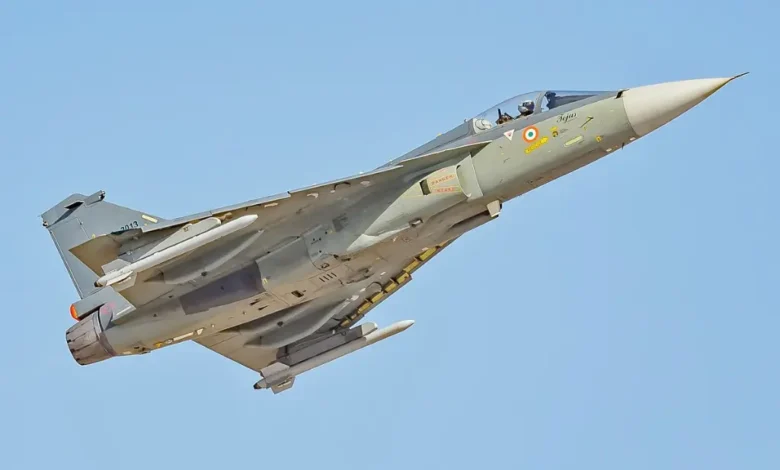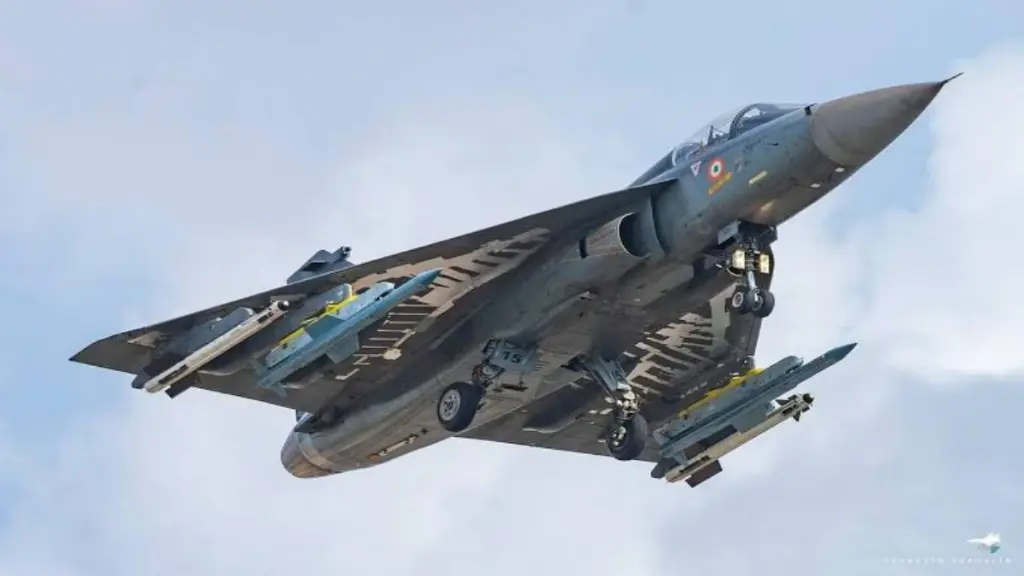HAL Tejas

The HAL Tejas is a lightweight, single-engine, multirole fighter aircraft developed by Hindustan Aeronautics Limited (HAL) for the Indian Air Force and Navy. First flown in 2001 and introduced in 2016, the Tejas is designed for air superiority, ground attack, and reconnaissance missions. It is India’s first domestically developed fourth-generation fighter and represents a significant milestone in the country’s aerospace industry.
Fact Sheet
| Role | Multirole fighter |
|---|---|
| Manufacturer | Hindustan Aeronautics Limited (HAL) |
| First Flight | 2001 |
| Service Entry | 2016 |
| Crew | 1 |
Specifications
| Length | 13.2 m (43 ft 4 in) |
|---|---|
| Wingspan | 8.2 m (26 ft 11 in) |
| Height | 4.4 m (14 ft 5 in) |
| Empty Weight | 6,560 kg (14,460 lb) |
| Max Takeoff Weight | 13,500 kg (29,762 lb) |
| Powerplant | 1 × General Electric F404-GE-IN20 turbofan |
| Thrust | 19,000 lbf (84.5 kN) with afterburner |
| Max Speed | Mach 1.8 (2,205 km/h; 1,370 mph) |
| Service Ceiling | 16,000 m (52,500 ft) |
| Range | 1,150 mi (1,850 km) combat radius |
| Rate of Climb | ~50,000 ft/min (254 m/s) |
Avionics & Armament
| Main Radar | EL/M-2052 AESA radar |
|---|---|
| Avionics | Advanced avionics suite, electronic warfare systems |
| Armament | One 23-mm GSh-23 cannon; Up to 8 external hardpoints for: – Air-to-air missiles (Astra, Derby, Python-5) – Air-to-ground munitions (bombs, rockets) – Precision-guided bombs – External fuel tanks |
Notable Features
- Lightweight and agile design for superior maneuverability.
- Multirole capability for air-to-air and air-to-ground missions.
- Indigenous development showcasing India’s aerospace capabilities.
- Advanced avionics for superior situational awareness.
- Continuously upgraded with new variants like the Tejas Mk1A and Mk2.

HAL Tejas: India’s Indigenous Light Combat Aircraft
The HAL Tejas (Sanskrit: तेजस, meaning “Radiant”) is an indigenous Indian single-engine, delta-wing, light multirole fighter aircraft. Designed by the Aeronautical Development Agency (ADA) and manufactured by Hindustan Aeronautics Limited (HAL), the Tejas represents a significant stride in India’s pursuit of self-reliance in aerospace technology and aims to replace the Indian Air Force’s (IAF) aging fleet of MiG-21 fighters.
Tejas Program Development & Objectives
The Light Combat Aircraft (LCA) program for the Tejas was initiated in the early 1980s with a core objective: to indigenously develop a modern fighter aircraft. This involved mastering critical technologies like the fly-by-wire (FBW) flight control system and advanced avionics. The first technology demonstrator, TD-1, achieved its maiden flight in January 2001. The aircraft was formally named “Tejas” in 2003. After extensive testing, the Tejas received Initial Operational Clearance (IOC) in 2011 and Final Operational Clearance (FOC) in 2019.
Tejas Design Features: Agile Delta Wing & Composites
The Tejas features a tailless delta-wing configuration, providing inherent agility and efficient supersonic performance. It is distinguished as one of the smallest and lightest supersonic combat aircraft in its class.
- Single Engine Powerplant: The Tejas Mk1 is powered by a General Electric F404-GE-IN20 afterburning turbofan engine. While an indigenous Kaveri engine was initially planned, the F404 serves as a reliable interim solution.
- Aerodynamic Performance: The optimized delta wing design allows for excellent flight characteristics across a wide envelope, reaching speeds of up to Mach 1.8 at high altitudes and sustaining +9/-3.5 G maneuvers.
- Advanced Composite Materials: The airframe extensively utilizes carbon-fiber composites, making up 45% of the airframe by weight and 95% by surface area. This significantly reduces weight while maintaining structural integrity.
- Digital Fly-by-Wire (FBW) System: A quadruplex digital FBW system provides precise, highly responsive flight control and enhances the aircraft’s inherent maneuverability.
- Air-to-Air Refueling (AAR): Modern variants like the Tejas Mk1A and future models are equipped with an in-flight refueling probe, crucial for extending combat range and endurance during missions.
Tejas Avionics & Armament: Modern Sensors & Diverse Weaponry
The Tejas is equipped with a modern and continually evolving avionics suite designed to support its multirole capabilities.
- Radar Systems: The Tejas Mk1 uses an Elta EL/M-2032 hybrid multi-mode fire control radar. The more advanced Tejas Mk1A will incorporate either an improved Elta EL/M-2052 AESA radar or the indigenously developed Uttam AESA radar, providing superior multi-target tracking and enhanced air-to-air and air-to-ground modes.
- Electronic Warfare (EW) Suite: It integrates an advanced EW suite for self-protection against threats, with the Mk1A featuring enhanced indigenous or Israeli EW systems.
- “Glass Cockpit” & Displays: The cockpit is modern, compatible with night vision goggles (NVG), and features multiple reconfigurable multi-function displays (MFDs) and a Head-Up Display (HUD), presenting pilots with a clear and comprehensive tactical picture.
- Weapon Payload & Hardpoints: The Tejas has 9 external hardpoints (8 for the Mk1), offering a total external payload capacity of up to 5,300 kg (11,700 lb).
- Internal Cannon: Equipped with one 23mm twin-barrel GSh-23 cannon.
- Air-to-Air Missiles (AAMs): Capable of carrying Derby (Beyond Visual Range – BVR), Astra (BVR), Python 5 (Within Visual Range – WVR), and R-73 (WVR). Future integration includes Astra Mk2 & Mk3 and ASRAAM missiles.
- Air-to-Surface Weapons: Can deploy various precision-guided munitions (PGMs), laser-guided bombs (LGBs), cluster munitions, and unguided bombs. It is slated for integration of advanced weaponry such as Hammer PGMs, Sudarshan LGBs, Spice-2000 smart bombs, and BrahMos-NG cruise missiles.
Tejas Variants & Future Development: Mk1A, Mk2 & Naval Plans
The Tejas program is continuously evolving, with several key variants and ambitious future plans.
- Tejas Mk1: The initial single-seat operational variant currently in service with the IAF.
- Tejas Mk1A: This is an advanced, battle-ready version with over 40 significant improvements. Key enhancements include a new avionics suite with AESA radar, upgraded EW capabilities, in-flight refueling, and improved weapons integration. The first production Tejas Mk1A aircraft (LA 5033) conducted its maiden flight on March 28, 2024. Deliveries to the IAF are expected to commence by the end of 2025, with HAL aiming to deliver all 83 aircraft in the current order by 2031-32, increasing its production rate to 24 units annually from 2027.
- Tejas Mk2 (Medium Weight Fighter – MWF): A significantly larger and more capable variant under development. It will feature canards, a more powerful General Electric F414 INS6 engine, increased payload capacity (up to 6.5 tons), and extended range. Metal cutting for the Mk2 began in February 2021. The first prototype rollout is expected by 2025, with a first flight within 2026. Mass production is targeted for 2029, with deliveries to the IAF from 2032.
- Naval Tejas (NP-1/NP-2): Naval prototypes developed for the Indian Navy. The NP-2 successfully performed its first arrested landing and ski-jump assisted take-off from INS Vikramaditya in January 2020, and later from INS Vikrant in February 2023. While these prototypes validated naval aviation technologies, the Indian Navy is currently evaluating the Twin Engine Deck Based Fighter (TEDBF) and potentially the Dassault Rafale M to meet its future carrier-based fighter requirements.
Tejas Operators & Operational History: IAF’s Active Fleet
- India (Indian Air Force – IAF): The sole operator of the Tejas.
- The first Tejas squadron, No. 45 Squadron “Flying Daggers,” became operational in July 2016, primarily replacing MiG-21s.
- No. 18 Squadron “Flying Bullets” also received FOC-standard Tejas Mk1 aircraft in May 2020.
- The IAF currently has orders for 123 Tejas aircraft (including Mk1 and Mk1A variants) and plans to procure 97 more, bringing the total to 220 aircraft.
Tejas Combat Record & Global Presence
The HAL Tejas has no confirmed combat kills in actual warfare. Its operational history has primarily involved:
- Domestic Deployments: No. 45 Squadron was operationally deployed along the Pakistani border in August 2020, marking a significant milestone for the indigenous fighter.
- International Exercises: The Tejas made its first international appearance outside India during Exercise Desert Flag VIII in the UAE in February-March 2023, demonstrating its capabilities in a multinational environment.
- Export Prospects: While India actively promotes the Tejas for export, engaging in discussions with several countries including Malaysia, Botswana, and Egypt, no firm export orders have been announced as of July 2025. HAL is increasing its production capacity to meet domestic demands and enhance its appeal for potential foreign buyers.
The Tejas program is a testament to India’s ambitious drive for self-reliance in defense manufacturing. Despite a lengthy and complex development journey, the Tejas has matured into a capable 4th/4.5-generation light combat aircraft. With ongoing upgrades and the development of the more advanced Mk2 variant, the Tejas is poised to become a vital component of the Indian Air Force fleet for decades to come, moving beyond a MiG-21 replacement to a key multirole asset.



